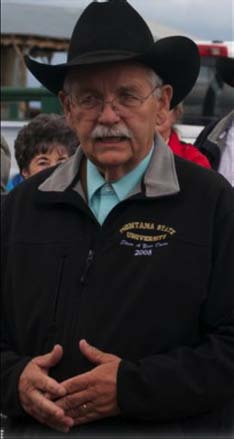Dr. John A. Paterson

Retired April 2012
Professor of Animal Science &
Extension Beef Specialist
Education
B.S. Western New Mexico University, Chemistry1973
M.S. Utah State University, Animal Science 1976
Ph.D. University of Nebraska, Ruminant Nutrition 1979
Classes
ARNR 230 Range Livestock Production.
Research Interests
- Research Emphasis
- Beef cattle mineral/protein nutrition
- Forage utilization
- Toxicology
- Extension Emphasis
- Nutritional programs for cows in late gestation, computer software, beef quality assurance
Accomplishments and Interests
- Demonstrated that the toxic alkaloid in tall fescue reduced blood flow to peripheral and core body tissues in cattle.
- Demonstrated that inclusion of high fiber byproduct feedstuffs into supplements resulted in similar animal gains as cereal grain-based supplements.
- Demonstrated that weaned heifers supplemented with high levels of Zn had reduced storage of Cu in the liver.
- Demonstrated that undegradable intake protein stimulated daily gain in first calf heifers.
- 2011 WASAS Award
Recent Publications
- Reddin, R., L.M. Surber, B. Roeder, B. Nichols, J.A. Paterson, and R. Kott. 2011. Performance, residual feed intake and feeding behavior of Targhee ewes receiving growing diets as lambs and maintenance diets as yearlings. J. Anim. Sci. (submitted)
- Waterman, R.C., T.W. Geary, J.A. Paterson and R.J. Lipsey. 2011. Early weaning in northern great plains beef cattle production systems: Performance and reproductive response in range beef cows. Livestock Production. (submitted)
- Waterman, R.C., T.W. Geary, J.A. Paterson and R.J. Lipsey. 2011. Early weaning in northern great plains beef cattle production systems: II. Development of replacement heifers weaned at 80 or 215 d of age. Livestock Prod. (submitted)
- Roberts, A.J., L.E. Wallace, M. Harbac and J.A. Paterson. 2011. Retention and readability of radio frequency identification transponders in beef cows over a three or four year period. Prof. Anima. Scientist. (submitted)
- Redden, R.R., L.M.M. Surber, B.L Roeder, B.M. Nichols, J.A. Paterson and R.W. Kott. 2011. Residual feed efficiency established in a post-weaning growth test may not result in more efficient ewes on the range. Small Ruminant Research. doi10.1016.
- McDonald, T.J., G.W. Brester, A. Bekkerman and J.A. Paterson. 2010. Case Study: Searching for the ultimate cow: The economic value of residual feed intake at bull sales. Prof. Anim. Scientist 26:655-660.
- Lardy, G.P., B.A. Loken, V.L. Anderson, D.M. Larson, K.R. Maddock-Carlin, B. R. Ilse, R. Maddock, R. Clark, J.A. Paterson, and M.L. Bauer. 2008. Field Pea Inclusion in Finishing Diets: Increasing field pea (Pisum sativum) level in high concentrate diets. 2. Effects on growth performance and carcass traits in finishing steers and heifers.J.Anim. Sci. 87:3335-3341.
- L. E. Wallace, J. A. Paterson, R. Clark, M. Harbac, and A. Kellom . 2008. Readability of Thirteen Different Radio Frequency Identification Ear Tags by Three Different Multi-Panel Reader Systems for Use in Beef Cattle. Prof. Animal Sci . 24:384-391.
- Choat, T., J. Paterson, G. Smith, K. Belk, M. King and B. Rainey. 2006. Effects of beef cattle gender on tenderness of steaks. J. Anim. Sci. 84:1820-1826
